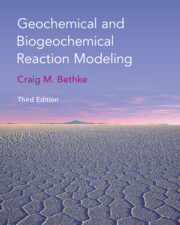Book contents
- Frontmatter
- Dedication
- Contents
- Preface
- Preface to Second Edition
- Preface to First Edition
- A Note About Software
- 1 Introduction
- 2 Modeling Overview
- PART I EQUILIBRIUM IN NATURAL WATERS
- PART II REACTION PROCESSES
- 14 Mass Transfer
- 15 Polythermal, Fixed, and Sliding Paths
- 16 Geochemical Buffers
- 17 Kinetics of Dissolution and Precipitation
- 18 Redox Kinetics
- 19 Microbial Kinetics
- 20 Association and Dissociation Kinetics
- 21 Kinetics of Gas Transfer
- 22 Stable Isotopes
- 23 Transport in Flowing Groundwater
- 24 Reactive Transport
- 25 Stagnant Zones
- PART III APPLIED REACTION MODELING
- Appendix A Sources of Modeling Software
- Appendix B Evaluating the HMW Activity Model
- Appendix C Minerals in the LLNL Database
- Appendix D Nonlinear Rate Laws
- References
- Index
25 - Stagnant Zones
from PART II - REACTION PROCESSES
Published online by Cambridge University Press: 09 December 2021
- Frontmatter
- Dedication
- Contents
- Preface
- Preface to Second Edition
- Preface to First Edition
- A Note About Software
- 1 Introduction
- 2 Modeling Overview
- PART I EQUILIBRIUM IN NATURAL WATERS
- PART II REACTION PROCESSES
- 14 Mass Transfer
- 15 Polythermal, Fixed, and Sliding Paths
- 16 Geochemical Buffers
- 17 Kinetics of Dissolution and Precipitation
- 18 Redox Kinetics
- 19 Microbial Kinetics
- 20 Association and Dissociation Kinetics
- 21 Kinetics of Gas Transfer
- 22 Stable Isotopes
- 23 Transport in Flowing Groundwater
- 24 Reactive Transport
- 25 Stagnant Zones
- PART III APPLIED REACTION MODELING
- Appendix A Sources of Modeling Software
- Appendix B Evaluating the HMW Activity Model
- Appendix C Minerals in the LLNL Database
- Appendix D Nonlinear Rate Laws
- References
- Index
Summary
In modeling the transport of chemical mass within flowing groundwater, the diffusion of chemical species into and out of stagnant zones within the domain can exert a controlling influence on the calculation results. This chapter shows how to incorporate the effect of stagnant zones on mass transport into a numerical flow and transport model. In a worked example, we show that the presence of stagnant zones can retard contaminant migration within an aquifer but lead to a strong tailing effect that interferes with environmental remediation.
Keywords
- Type
- Chapter
- Information
- Geochemical and Biogeochemical Reaction Modeling , pp. 303 - 310Publisher: Cambridge University PressPrint publication year: 2022

